How to Play the Card Game Juse
|
|
Juse is a card game from Sri Lanka which contains features common to some other multi-player, competitive solitaire type games. It can be played by 2 to 8 players and uses one standard 52 card deck. The ranking of the cards in this deck are as follows (from high to low): Ace, King, Queen, Jack, 10, 9, 8, 7, 6, 5, 4, 3, 2, Ace. It should thus be noted that the Ace is ranked both as the highest card and the lowest card in the deck, and as such, running sequences can continue indefinitely (i.e. a sequence of cards consisting of Jack, Queen, King, Ace, 2, 3, 4 is considered a legal such sequence).
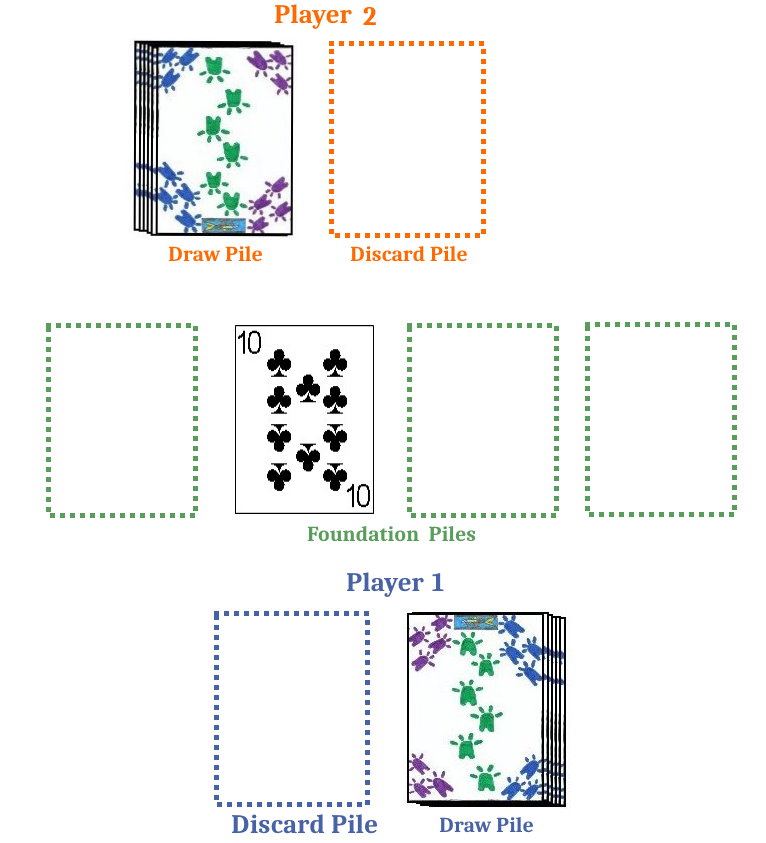 Determination of seating positions and first dealer can be performed in a variety of ways, with drawing for high cards a common method. For purposes of this draw, Ace is considered the highest card and
2 the lowest. The players would thus take seats at the table in the order of cards drawn from highest to lowest. If two or more players draw cards of equal rank, they should discard those cards and draw another card, continuing to discard and draw until drawing cards of a denomination that no other player has drawn. The player drawing the highest card of all is set as the first dealer. After each game, the deal rotates around the table in a clockwise direction.
Determination of seating positions and first dealer can be performed in a variety of ways, with drawing for high cards a common method. For purposes of this draw, Ace is considered the highest card and
2 the lowest. The players would thus take seats at the table in the order of cards drawn from highest to lowest. If two or more players draw cards of equal rank, they should discard those cards and draw another card, continuing to discard and draw until drawing cards of a denomination that no other player has drawn. The player drawing the highest card of all is set as the first dealer. After each game, the deal rotates around the table in a clockwise direction.
Once the players are seated and the first dealer determined, the dealer thoroughly shuffles the deck and offers it to the player at his right to cut. After the cut, the dealer begins dealing the cards around the table in a clockwise direction, one by one and starting with the player at his immediate left. He continues dealing until the deck is reduced to just one card. The dealer then places this card face-up in the middle of the table to start the first foundation pile. The players should not actually look at the cards they have been dealt, but instead place them in a neat, squared up face-down
pile in front of themselves, which is that player's draw pile. During the deal, some players may receive one more card than other players, which is acceptable and will often occur.
The player to the immediate left of the dealer has the first turn, and the turns rotate in a clockwise direction around the table.
On each player's turn, that player may continue making legal moves as long as
able, which consists of making plays from that player's discard pile to center
foundation piles as well as other player's discard piles if applicable. At the
start of the game, each player will only have a draw pile in front of themselves
and no discard pile, so each player's first turn is slightly different than
subsequent turns by that player. Thus, on each players first turn, he simply draws the top card from his draw pile. If able to play this card in a legal play (see below) he does so, and may then draw another card
from his draw pile, continuing to do so until unable to make further plays. He finishes his turn, by placing the last unplayable that was drawn next to his draw pile to start his face-up discard pile.
On a player's second and subsequent turns, the player begins his turn by playing cards from the top of his draw pile if able. Once unable to play additional cards from his draw pile, he then draws the top card of his draw pile. If able to legally play that card he does so, and draws another card from his draw pile. In the process, if the opportunity arises to play the current top card of the discard pile, he may do so. Once he is unable to play the card drawn from his draw pile, he ends his
turn by placing the last card drawn on the top of his discard pile. During play,
it may occur that a player may completely depletes his discard pile (by making legal plays from that pile), in that case his only play would be to draw a card from the draw pile and playing the card if able. If unable to play the card he instead starts a new discard pile with this card, ending his turn.
It may also occur that the player depletes his draw pile in drawing cards from that pile. In that case, the player may continue making legal players from his discard pile as able. Once the player is no longer able to make legal plays from the top of his discard pile, the turns the entire discard pile over, to make a new face-down draw pile. He then draws the top card from this pile and continues his turn as normal. Once unable to play a card drawn from his new draw pile, he starts a new discard pile with the unplayable card.
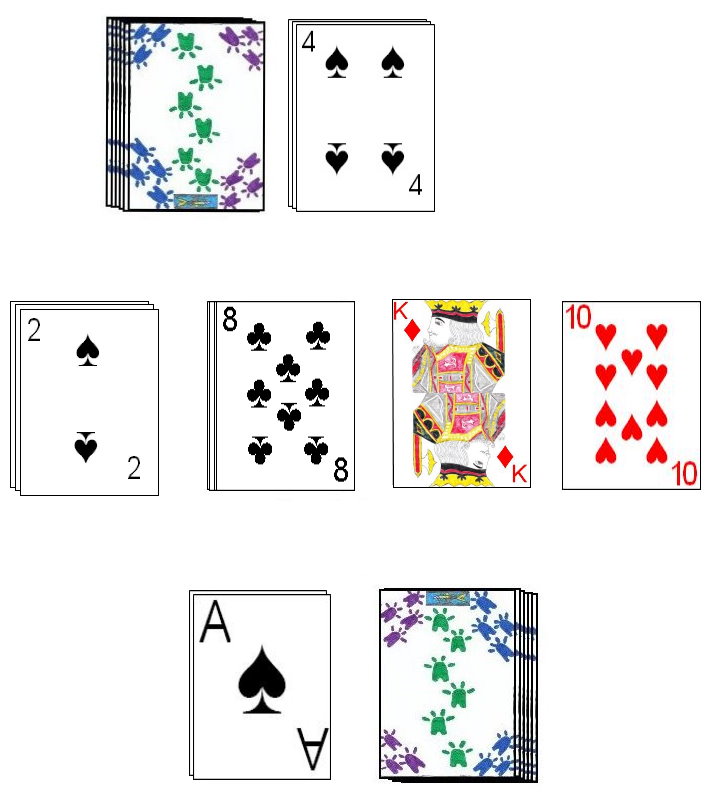 The following are the legal plays that a player may make during his turn:
The following are the legal plays that a player may make during his turn:
- If a player has a card of the exact same denomination as the first foundation card set by the dealer (but of a different suit), this can be placed to start a new foundation pile, which should be set next to any other foundation piles which are currently found on the table.
- If a player has a card of the same suit and next in ascending sequence to the top card in any of the foundation piles, he may play the card onto the top of that foundation. It should be noted that after the Ace is played, the next in sequence would be the two, after which the sequence can begin climbing again.
- If a player has a card which is exactly one rank higher (regardless of the suit) as the current top card of any other player's discard pile, he may play that card onto the top of that pile.
In most cases, on a turn, not only is player entitled to play a card as able, he is usually required to. Failure to make a required play can result in a penalty for that player, which any other player can bring attention to by shouting "Juse" and then indicating the misplay for that player. The following describes the required plays:
- If on a player's turn, the top card of his discard pile can be played to one of the foundation piles, this card must be played before the player even touches his draw pile.
- If a card can be played on both an opponent's discard pile and to one of the center foundation piles, the card must be played to the foundation pile as applicable.
- If a card can be played to start a new foundation pile (being of the same denomination as the original foundation card dealt by the dealer), the player must play this card to start that foundation pile.
In addition, to failure to make a required play, other actions that might incur a "Juse" call and a penalty are playing out of turn, playing a card on the incorrect discard pile, playing a card to your discard pile when it could have been played elsewhere. Once a valid call of "Juse" is declared, the penalty is for each other player to give the bottom card in that player's face-down draw pile to the offender. These cards are added to the bottom of the offending player's draw pile. If one of the other player's has no draw pile when the penalty is committed, that player instead gives the player the bottom card of his discard pile. In addition, the invalid play must be corrected.
Play continues until one player manages to completely deplete both his draw pile and discard pile, having no cards remaining, that player is immediately declared the winner of the game.
Variations and Optional Rules
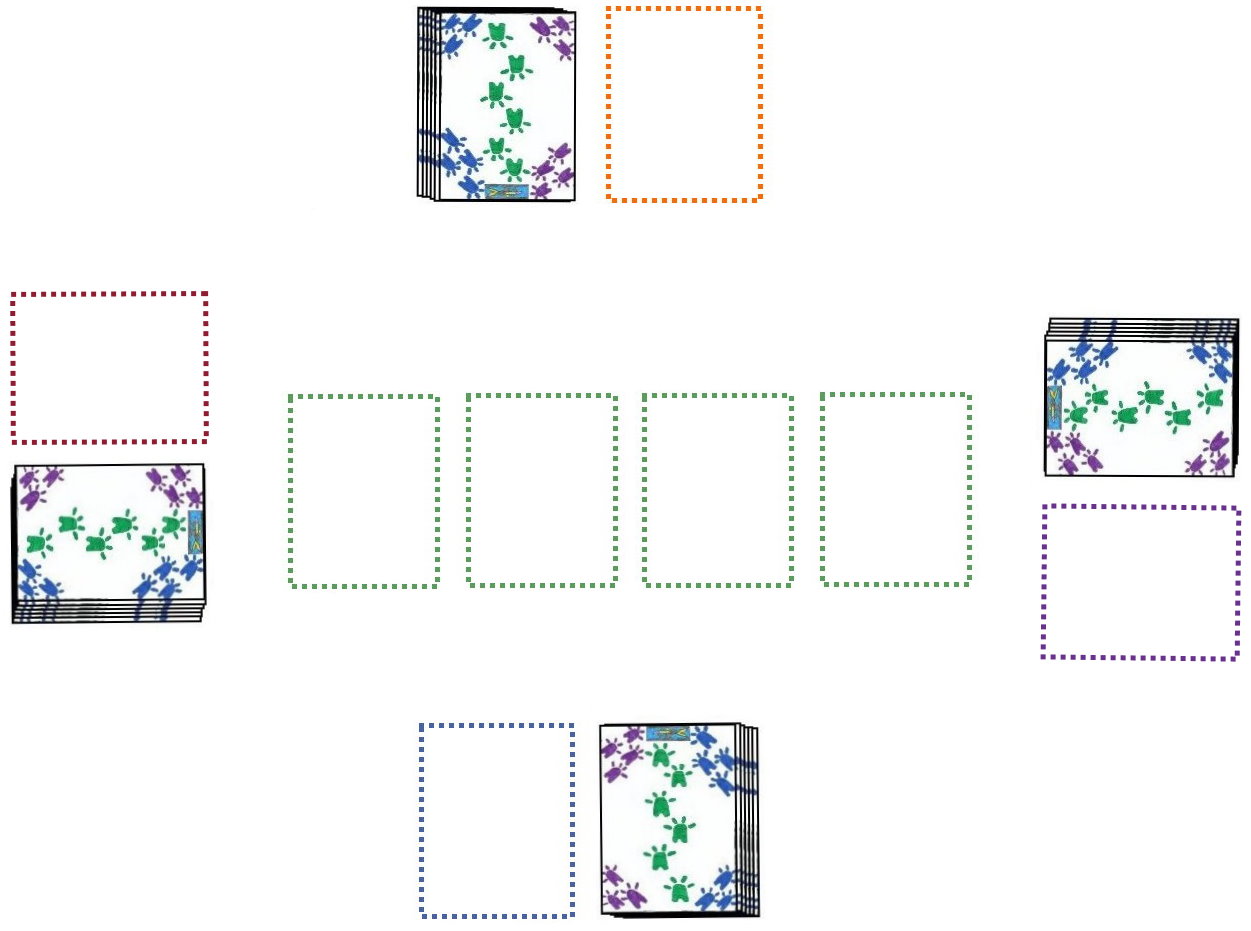 Dozdakaan: Dozdakaan is a game played similar to Juse which is commonly played in Afghanistan. The rules are very similar to those as used in Juse, with the following differences:
Dozdakaan: Dozdakaan is a game played similar to Juse which is commonly played in Afghanistan. The rules are very similar to those as used in Juse, with the following differences:
- The ranking of the cards is similar to that in the standard game (namely, from high to low, Ace, King, Queen, Jack, 10, 9, 8, 7, 6, 5, 4, 3, 2). An Ace is considered the highest card and thus no other card can be played as a sequence on top of an Ace.
- The entire deck is dealt out amongst the players. The dealer does not deal a card face-up to the table. Instead, the player who receives the last card is entitled to have the first play of the game, with the turns, as normal rotating in a clockwise direction around the table.
- Each player begins each turn by playing any cards from his discard pile (if he has one) as playable from that top of that pile. Once unable to make any more plays from his discard pile, he then draws a card from his draw pile, and if able to play the card does so, continuing to draw cards as long as he is able to make a legal play of that card anywhere except to his own discard pile. Once the player has no other legal players, he places the currently drawn card face-up on top of his discard pile, ending his turn.
- If a player discards to his discard pile in this way without realizing he had a legal play, his turn is still over, but no penalty is called. However on his next turn, he should begin the turn by playing this card as able.
- If a player at any time has a 2, he must play it to the middle of the table to start a new foundation pile. Once foundation piles have been created in the middle of the table, players may play cards in ascending sequence to these piles as able, which must be of the same suit and one rank higher than the previous card on that pile.
- Once a player plays the last of his cards from his discard and draw piles, he drops from the game. The game continues until all but one player have managed to play all his cards, with the last player, considered the loser of the game, given the title of dozd (the thief).
In all other aspects Dozdakaan is played identically to Juse, as described above.
Alte Jungfer: Alte Jungfer is a German card game played similarly to
Juse. Alte Jungfer translates to Old Maid in English but should not be confused
with the common children's game with that name. The game is designed for 3 to 8 players and uses one standard 52 card deck. The ranking of the cards in this game are as follows, from highest to lowest; King, Queen, Jack, 10, 9, 8, 7, 6, 5, 4, 3, 2,
Ace.
Alte Jungfer is played identically to Juse, with the following differences:

- The entire deck is dealt out to the players, with some players getting one extra card. The last card from the deck is dealt
out to the players and not to the center of the table as it normally would be in Juse.
- The four foundation piles must each start with the Ace. Thus, if a player exposes an Ace from his draw pile, he may immediately play the Ace to the center of the table, starting a new foundation in that suit.
- Cards are built onto these center piles from Ace to King, in ascending sequence. Each card played being one rank higher than the current card on that foundation pile and of the same suit. Cards can be played to these center piles, on a player's turn from the top, exposed card of his draw pile or from his discard pile, called his reserve.
- A player may only expose one card per turn from his draw pile, but may play as many cards from the top of his reserve pile as able
during his turn..
- Similarly, if a player has a card, either the current top card of his reserve, or the exposed card from his draw pile that is exactly one rank higher and of the same suit as the top card on an opponent's reserve pile, he may thus play the card to the top of that pile.
- If a player, at the end of his turn has been unable, during that turn, to play the exposed card from his draw pile during that turn, he must transfer it to the top of his face-up reserve pile.
- Once a player has depleted his draw pile, he simply continues play on each turn from his
reserve pile, playing cards from the top of that pile to other player's reserve piles or the center foundations as able on his turns.
- As players manage to completely deplete their hands (from both their draw pile and reserve pile) they drop from the game. The last player remaining with cards is said to have lost the game and is titled the Alter Jungfer (Old
Maid). If the situation arises in which no players have any remaining valid, legal moves, the game ends and the player with the most remaining card in his reserve pile is declared the Alte Jungfer, instead.
In all other aspects, this game is played identically to Juse, as described above.
Ti Vitti: Ti Vitti is a popular Italian game (particularly in Sicily and Calabria). The name of the game is roughly translated to "I saw you"
in the English language. The game is traditionally played using the 40 card
Italian deck. This deck consists of four suits (glasses, gold coins, sticks, and swords) in each
of eight denominations (1, 2, 3, 4, 5, 6, 7, Knave, Knight, King). If such an Italian deck is not at hand, a 52 card International pack can be reduced to form the necessary deck. This deck would be form by removing all cards of rank 8, 9, and 10 from a standard deck. The ranking of the cards used for this game is as follows (1 (Ace), 2, 3, 4, 5, 6, 7, Knave (Jack), Knight (Queen), King). Ti Vitti is designed for play by 2 to 4 players.
Determination of the first dealer and seating positions can be performed using a variety of methods, including a draw for high cards, with each player taking a seat in order of card ranks drawn, from highest to lowest. The player drawing the highest ranked card of all is set as the first dealer. After each game, the role of dealer would rotate around the table in a counter-clockwise direction.
The designated dealer would thus thoroughly shuffle the cards and offer it to the player at his left to cut. After the cut, he begins dealing the cards in a counter-clockwise direction, starting with the player at his right. He deals the cards face-down and one-at-a-time, continuing until all the cards have been dealt. If any players receive an extra card, this is acceptable as any differences will even out over the course of multiple hands. Each player takes the cards dealt to him and places them in a neat, face-down pile, and does not look at his cards. The player to the right of the dealer has the first turn, and the turns rotate around the table in a counter-clockwise direction.
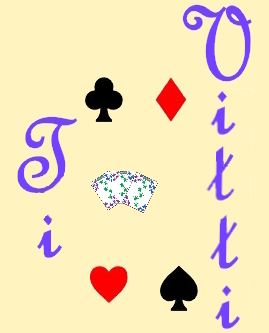 A player begins his turn by turning over the top card of his dealt pile. If
this card is an Ace of any suit, he places this card in the center of the table,
to start the foundation piles. If he is able to play the card turned over, after
playing the card, he may then turn over the next card from the pile, continuing
to turn over additional cards as long as he is able to continue playing the card
turned over. Once he is unable to play the drawn card, he then starts a face-up
discard pile next to his face-down pile, and the next player in turn has their
play.
A player begins his turn by turning over the top card of his dealt pile. If
this card is an Ace of any suit, he places this card in the center of the table,
to start the foundation piles. If he is able to play the card turned over, after
playing the card, he may then turn over the next card from the pile, continuing
to turn over additional cards as long as he is able to continue playing the card
turned over. Once he is unable to play the drawn card, he then starts a face-up
discard pile next to his face-down pile, and the next player in turn has their
play.
As players continue to play, additional options will be revealed for play. Each player always starts his turn by turning over the top card from his play pile and places it on top of his discard pile. The following are the potential plays a player can make, using the card drawn, as well as further cards from his discard pile:
- If a player has an Ace, he must play this card to the center of the table. This will start a foundation of cards which can be played in this suit.
- If a player has the next highest card in the same suit as the current top card of one of the foundation piles, he may play the card to the top of that pile.
- If a player has a card that is exactly one rank lower or one rank higher than the top card of another player's discard pile, he may play the card on top of that players discard pile. If the top card of that discard pile is a 1 (Ace), he may play a King on top of that pile.
As long as a player is able to play the card flipped from his draw pile, he may continue taking additional turns, until no longer able to make a legal play.
Players should always remain alert, as if they see another player either intentionally or unintentionally make an error or fail
to make a required play, they may loudly declare "Ti Vitti" ("I see you"). They may thus declare this in the following circumstances:
- Another player fails to make a legal play to a center pile if able, on their turn.
- Another player fails to make a legal play to the top of an opponent's discard pile, if able.
- Another player plays to an opponent's discard pile in the event that same card could have been played to one of the middle foundation piles.
In the event that an opponent calls Ti Vitti, that player must point out the infraction, and if valid, the player to which "Ti Vitti" was called on, must then place the top two cards from their discard pile back on their draw pile (face-down), and that player's turn immediately ends, continuing with the next player's turn. If the "Ti Vitti" was call on a player who played a card to an opponent's discard pile instead of the correct middle foundation pile, they must take that card back from the top of that opponent discard pile, placing it back, face-down on the top of their draw pile, and their turn immediately ends.
If a player turns over the last card of his draw pile, and is unable to play, once his turn is over, he then turns over the discard pile to start a new draw pile, which he can then turn over it's top card beginning with his next turn.
The game continues from turn to turn, player to player, until one player manages to play his last card, with that player set as the winner of the game.
Muggins: Muggins is an
old card game from England, which was much played by children during Victorian
times. The most popular variant is for four players, but it can also be easily
adapted for play by three, five, six or seven. The game is played using one standard 52 card International deck. The ranking of the cards as used for playing the game is as follows (from highest to lowest): King, Queen, Jack, 10, 9, 8, 7, 6, 5, 4, 3, 2, Ace. The deal consists of
the designated dealer distributing an equal number of cards face-down to each player and additional cards face-up on the table (called the muggins or muggin cards). The following chart shows the number of cards dealt
to each player and the table based on the number of participants:
| Number of Players | Cards Dealt per Player | Cards dealt to Table |
|---|
| 3 | 17 | 1 |
| 4 | 12 | 4 |
| 5 | 10 | 2 |
| 6 | 8 | 4 |
| 7 | 7 | 3 |
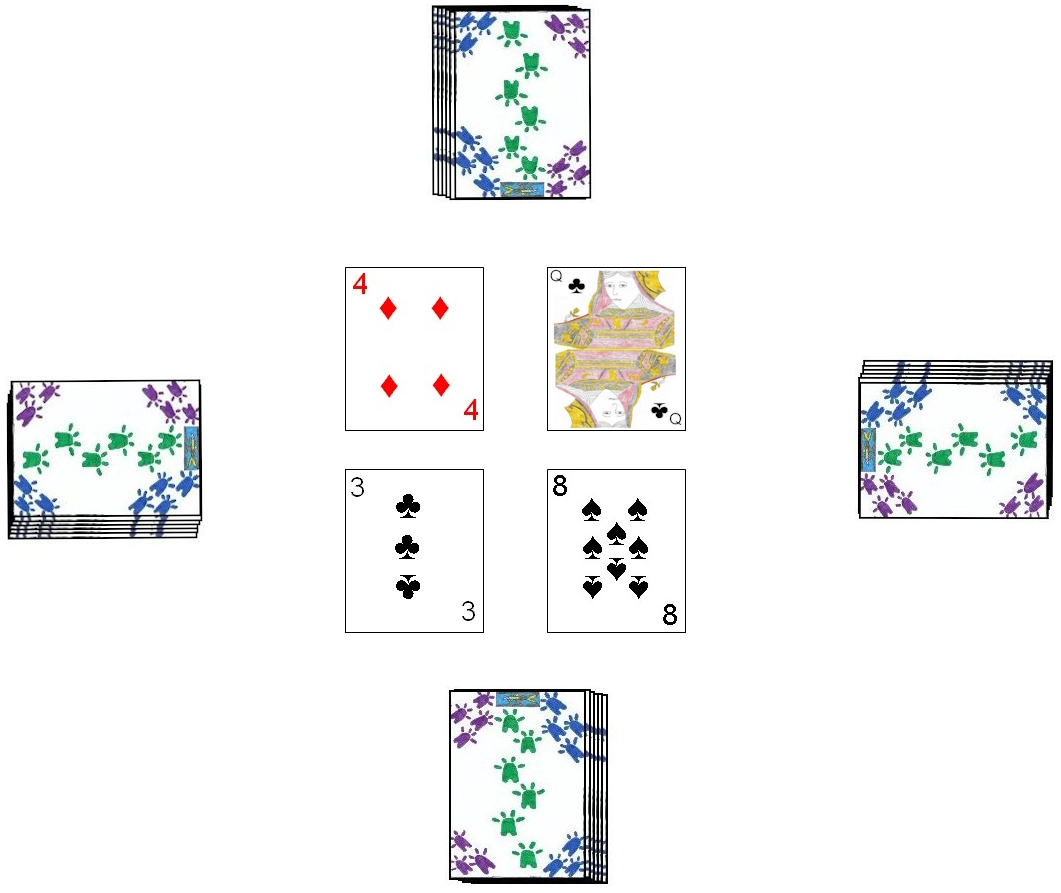 Each player stacks the cards dealt to him in a face-down pile in front of themselves, and may not look at these cards. The player to the immediate left of the dealer has the first turn and the turns rotate in a clockwise direction around the table.
Each player stacks the cards dealt to him in a face-down pile in front of themselves, and may not look at these cards. The player to the immediate left of the dealer has the first turn and the turns rotate in a clockwise direction around the table.
Each players turn starts by turning up the top card of his pile of dealt cards. He then determines if this card can be played, based on the following rules:
- If the card turned is exactly one rank higher or lower than the top card of any of the muggins piles, he may play the card to the top of that pile. If the top card of a muggins pile is an Ace only a two can be played on it, and if the top card is a King only a Queen can be played on that pile.
- If there are no available plays to a muggins pile, but if the card exposed is exactly one rank higher or lower than another players exposed discard pile, he may play that card to the top of that discard pile. If there is a choice of such players, he must play it to the discard pile of the player who is nearest to his left, in rotation. As with the muggins pile, the only legal play to such a pile if the top card is an Ace is a two, and the only legal play to a King is a Queen.
If the player is unable to play it to either a muggins pile or an opponent's discard pile, he adds it face-up to the top of his personal discard pile, regardless of what rank the top card of his pile is. If his discard pile currently has no cards he begins a discard pile with the card.
If a player plays the last card from his stack and has no discard pile (thus running out of cards, that player is immediately declared the winner). However, if the player playing the last card from his stack still has any cards in his discard pile, he flips over his entire discard pile as his new face-down stack and will begin playing from that pile on his next turn.
If anyone notices another player making any illegal play (such as playing an invalid card to the muggins pile or playing to another player's discard pile instead of to a muggins pile
if able), that player may shout "Muggins" and point out the invalid play. The
offending player is then called a "Muggins". Each player (except the Muggins),
then takes the top card from their face-down stack and gives it to the Muggins
who must then place these cards at the bottom of his face-down pile. The player making the illegal play must also correct the invalid play (i.e. playing the invalidly played card to the correct location).
Copyright © 2015 CatsAtCards.com. All rights reserved.

 Determination of seating positions and first dealer can be performed in a variety of ways, with drawing for high cards a common method. For purposes of this draw, Ace is considered the highest card and
2 the lowest. The players would thus take seats at the table in the order of cards drawn from highest to lowest. If two or more players draw cards of equal rank, they should discard those cards and draw another card, continuing to discard and draw until drawing cards of a denomination that no other player has drawn. The player drawing the highest card of all is set as the first dealer. After each game, the deal rotates around the table in a clockwise direction.
Determination of seating positions and first dealer can be performed in a variety of ways, with drawing for high cards a common method. For purposes of this draw, Ace is considered the highest card and
2 the lowest. The players would thus take seats at the table in the order of cards drawn from highest to lowest. If two or more players draw cards of equal rank, they should discard those cards and draw another card, continuing to discard and draw until drawing cards of a denomination that no other player has drawn. The player drawing the highest card of all is set as the first dealer. After each game, the deal rotates around the table in a clockwise direction.
 The following are the legal plays that a player may make during his turn:
The following are the legal plays that a player may make during his turn:
 Dozdakaan: Dozdakaan is a game played similar to Juse which is commonly played in Afghanistan. The rules are very similar to those as used in Juse, with the following differences:
Dozdakaan: Dozdakaan is a game played similar to Juse which is commonly played in Afghanistan. The rules are very similar to those as used in Juse, with the following differences:

 A player begins his turn by turning over the top card of his dealt pile. If
this card is an Ace of any suit, he places this card in the center of the table,
to start the foundation piles. If he is able to play the card turned over, after
playing the card, he may then turn over the next card from the pile, continuing
to turn over additional cards as long as he is able to continue playing the card
turned over. Once he is unable to play the drawn card, he then starts a face-up
discard pile next to his face-down pile, and the next player in turn has their
play.
A player begins his turn by turning over the top card of his dealt pile. If
this card is an Ace of any suit, he places this card in the center of the table,
to start the foundation piles. If he is able to play the card turned over, after
playing the card, he may then turn over the next card from the pile, continuing
to turn over additional cards as long as he is able to continue playing the card
turned over. Once he is unable to play the drawn card, he then starts a face-up
discard pile next to his face-down pile, and the next player in turn has their
play.
 Each player stacks the cards dealt to him in a face-down pile in front of themselves, and may not look at these cards. The player to the immediate left of the dealer has the first turn and the turns rotate in a clockwise direction around the table.
Each player stacks the cards dealt to him in a face-down pile in front of themselves, and may not look at these cards. The player to the immediate left of the dealer has the first turn and the turns rotate in a clockwise direction around the table.